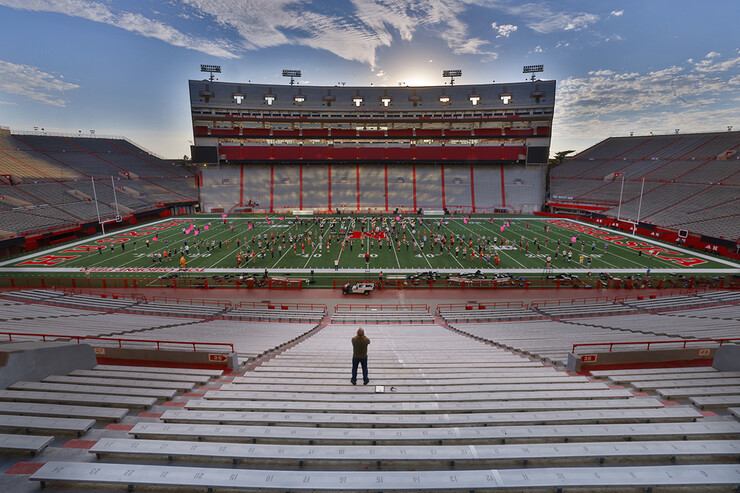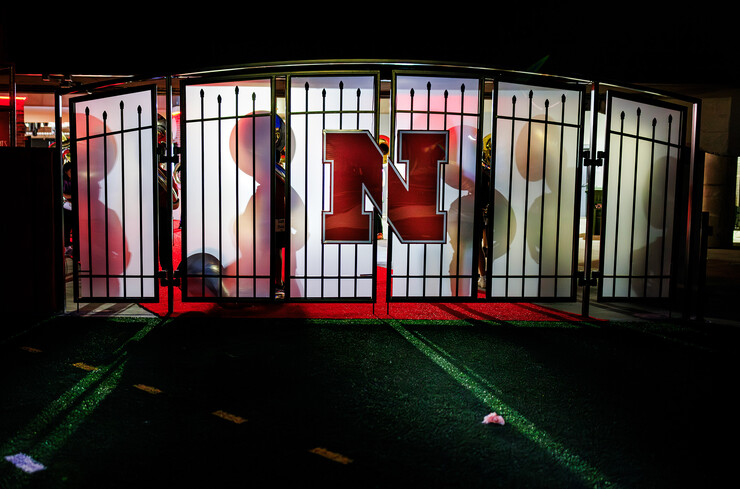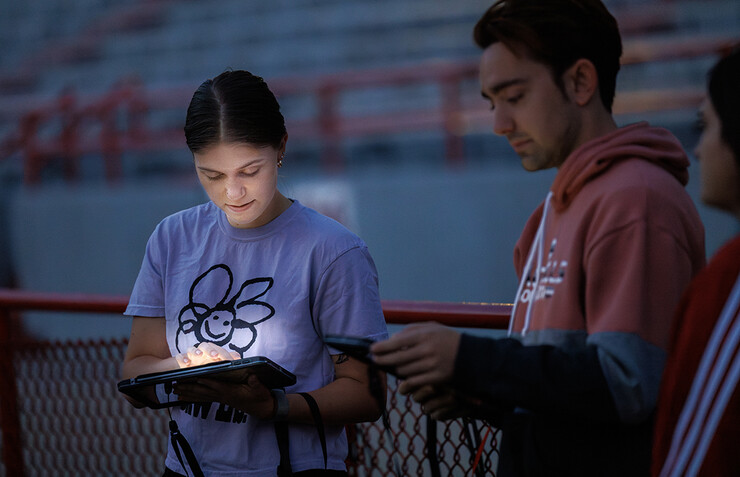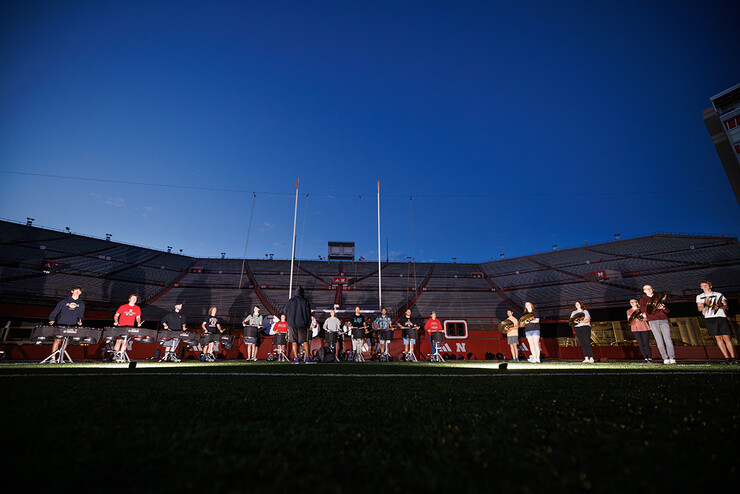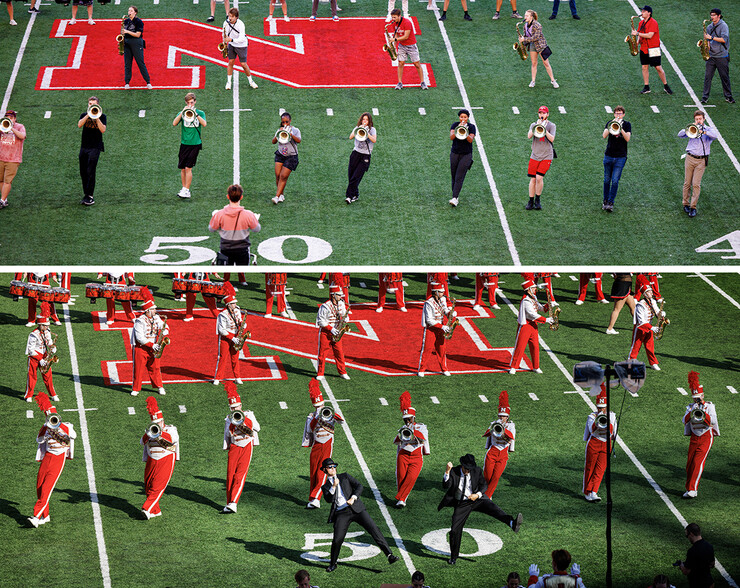· 8 min read
Halftime show comes together through early mornings, individual preparation
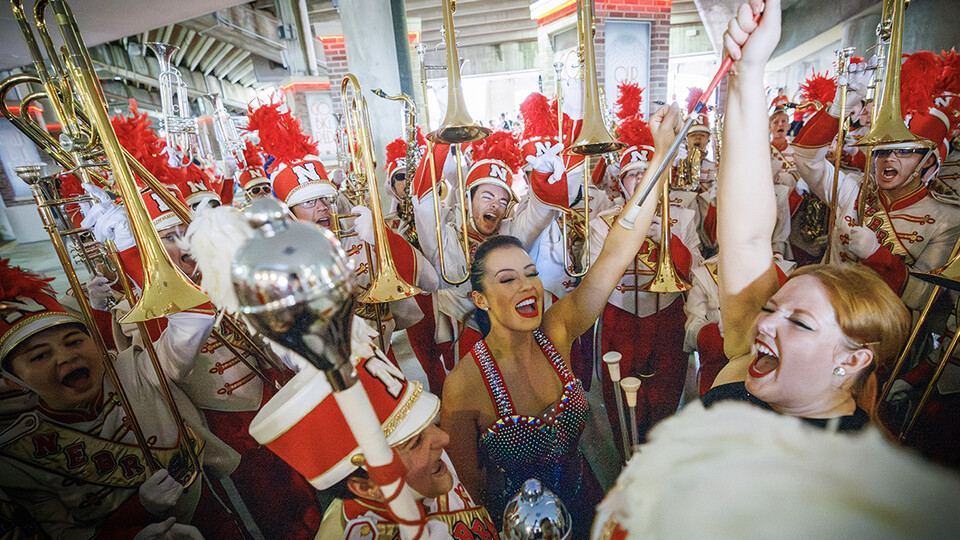
As the sun rises over Memorial Stadium most mornings, 299 University of Nebraska–Lincoln students are already at work.
Members of the Cornhusker Marching Band devote hours every week to developing the halftime entertainment for home football games. They spend the early mornings — as well as time on their own — to get ready to show off their skills on game day.
Andrew Linden, trumpet player and senior music performance and business management major from Minnetonka, Minnesota, said the group takes pride in the hard work they put into every show.
“I’m really proud to be part of it and to contribute to this thing that means so much to the state, and to the football program, and to the school,” Linden said. “It is the Pride of All Nebraska after all.”
The development of a new halftime show begins at 7 a.m. on Monday mornings, when the band does its first group run-through of that week’s music. Depending on how much time they’ve had to work on the previous show, they might have already had some time to start practicing the music.
After the music rehearsal, the students go to their first spot of the show and, move by move, the learn the drill, or formations they make during the show.
Students often get a jump start on the music on their own, by practicing it the week before they start rehearsing it as an ensemble. It’s typical for students to spend around an hour per week outside of scheduled rehearsal time practicing music.
“It’s like studying for any other class,” said Tony Falcone, associate director of bands and director of the marching band. “We try to play through everything a bunch to help reinforce that memorization.”
Last year’s band had more than 70 majors represented from across campus, from music to engineering. Falcone said some college students might be intimidated by the early start time, but he thinks students benefit from the structure.
“It ends up ordering their day,” Falcone said. “Because we rehearse first thing in the morning, they’re up and productive while a lot of people are still asleep, so that’s a big help for them. They learn how to organize their time.”
Trumpet player Lara Celesky, a fifth-year music education major from Ceresco, Nebraska, always plans ahead as much as possible. She said starting to learn what is available early makes every following step easier.
“If you’re more prepared with your music, that makes learning drill a lot easier,” Celesky said. “That way, you’re not learning two things at once.”
Drill is usually uploaded to an app the night before the ensemble starts learning it. Many students stay up late or wake up early to watch animations of the show to get an idea of how they will move from one spot to the next and how others move in relation to them.
“As soon as he uploads it, I’ll try to watch it and get a feel for it before we even put it on the field,” said Luke Partsch, a mellophone player and senior history and music major from Nebraska City, Nebraska.
Some will mark when movements happen in their music to help connect the two elements.
Falcone arranges the music for all the shows and Doug Bush, assistant director of bands, writes the drill. When the group has more time to prepare a show, there will probably be more moves into more complicated formations, and the music is often more difficult as well.
“If we have two or three weeks, we can do more intricate things,” Falcone said. “We keep it so they’re able to learn in the amount of time they have.”
Bush said they’ve developed a sort of formula for the number of sets to include in the show. They usually limit it to 10 to 12 moves per week of preparation.
“If I go higher than that, then it’s not a happy time,” Bush said.
Aside from that number, Bush said keeping drill simple isn’t so much about how elaborate the formations are as how difficult it is for marchers to get there.
“I’m always telling people it’s part art project, and it’s part math problem,” Bush said.
Once the music is selected, Bush starts thinking about what images are associated with that theme for inspiration for formations. If there’s one he wants to use during a short week, he looks for ways to make it easier to get into that formation. For example, they might use a “flutter,” which is when the marchers move to their next spot in a sort of run in a certain number of counts, rather than marching to it in a more rigid structure.
“If we’re not having to worry about keeping a line together as it moves, you can do more pictures because you’re not having to clean all that,” he said.
He also takes pacing into account, like starting the show with more moves because that often gets more repetition, or slowing down in the middle so they can end on a high with more exciting drill.
Partsch the more difficult shows add some adrenaline to weeks when there’s no game day and create a fun challenge.
“It’s generally quicker, it’s generally more complicated,” he said. “It makes it fun. If you have harder music and harder drill, it can really help you stay engaged.”
When there’s only one week between games, even things like someone being out for one day with a cold can make catching them up even more important. Tuba player Jacob Vollbrecht, a junior accounting major from Lincoln, said he tries to support other members, like letting them know he’ll be practicing his music on a certain evening so others can join if they want more rehearsal time.
“I’m always willing to give my personal time to help somebody if they need it,” he said.
Students meet in their instrument sections before regular rehearsal on Tuesdays. Leadership team does “mem checks,” when they’re quizzed on their memorization of the music, on Wednesday of game week, and the rest of the band does them on Thursday. By this point, they want to have the entire show on the field so that Friday’s rehearsal can be spent polishing it.
Game day starts with a two-hour rehearsal before the game. Smaller groups then play at the football team’s Unity Walk and tailgates. Those groups also play at local businesses on Friday night. The entire ensemble comes together again for a warm-up concert one hour before kickoff. That is typically by Kimball Recital Hall, but is outside Sheldon Museum of Art this season because of construction.
Participating in the Cornhusker Marching Band requires a lot of dedication, and Falcone said the students make that commitment because they love it. Falcone said he watches lifelong connections form between members.
“A bunch of people are going to meet their spouse,” Falcone said. “They may not know it yet. We really get to see those lifetime friendships.”
Those bonds become a second family, students said. Arriving for band camp, these are often the first people some of them meet on campus. For trumpet player Greg Johnson, junior sports media and communication major from Lincoln, getting to be part of game day experience together and feeling the support from Husker fans is special.
“I’ve been a big Husker football fan my whole life being from here, and wearing that uniform and performing on Saturdays, there’s nothing like it,” he said.
